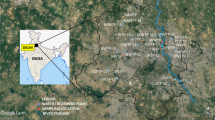Abstract
A total of 86 source water samples from 38 cities across major watersheds of China were collected for a bromide (Br−) survey, and the bromate (BrO3 −) formation potentials (BFPs) of 41 samples with Br− concentration >20 μg L−1 were evaluated using a batch ozonation reactor. Statistical analyses indicated that higher alkalinity, hardness, and pH of water samples could lead to higher BFPs, with alkalinity as the most important factor. Based on the survey data, a multiple linear regression (MLR) model including three parameters (alkalinity, ozone dose, and total organic carbon (TOC)) was established with a relatively good prediction performance (model selection criterion = 2.01, R 2 = 0.724), using logarithmic transformation of the variables. Furthermore, a contour plot was used to interpret the influence of alkalinity and TOC on BrO3 − formation with prediction accuracy as high as 71 %, suggesting that these two parameters, apart from ozone dosage, were the most important ones affecting the BFPs of source waters with Br− concentration >20 μg L−1. The model could be a useful tool for the prediction of the BFPs of source water.



Similar content being viewed by others
References
An W, Hu J, Giesy JP, Yang M (2009) Extinction risk of exploited wild roach (Rutilus rutilus) populations due to chemical feminization. Environ Sci Technol 43:7895–7901
Buxton GV, Greenstock CL, Helman WP, Ross AB (1988) Critical review of rate constants for reactions of hydrated electrons, hydrogen atoms and hydroxyl radicals. J Phys Chem Ref Data 17:513–886
Camel V, Bermond A (1998) The use of ozone and associated oxidation processes in drinking water treatment. Water Res 32:3208–3222
Civelekoglu G, Yigit NO, Diamadopoulos E, Kitis M (2007) Prediction of bromate formation using multi-linear regression and artificial neural networks. Ozone-Sci Eng 29:353–362
Jarvis P, Parsons SA, Smith R (2007) Modeling bromate formation during ozonation. Ozone-Sci Eng 29:429–442
Legube B (1996) A survey of bromate ion in European drinking water. Ozone-Sci Eng 18:325–348
Legube B, Parinet B, Berne F, Croue JP (2002) Bromate surveys in French drinking waterworks. Ozone-Sci Eng 24:293–304
Legube B, Parinet B, Gelinet K, Berne F, Croue JP (2004) Modeling of bromate formation by ozonation of surface waters in drinking water treatment. Water Res 38:2185–2195
Meenakshi VKG, Kavita R, Malik A (2004) Groundwater quality in some villages of Haryana, India: focus on fluoride and fluorosis. J Hazard Mater 106:55–60
Ministry of Health of the People’s Republic of China (2006) Standard test method for drinking water inorganic non-metallic targets (GB/T5750.5-2006), Standards Press of China, Beijing
Myllykangas T, Nissinen T, Vartiainen T (2000) Bromate formation during ozonation of bromide containing drinking water - a pilot plant study. Ozone-Sci Eng 22:487–499
Ozekin K (1994) Modeling bromate formation during ozonation and assessing its control. University of Colorado, Boulder
Ozekin K, Westerhoff P, Amy GL, Siddiqui M (1998) Molecular ozone and radical pathways of bromate formation during ozonation. J Environ Eng-ASCE 124:456–462
Pinkernell U, von Gunten U (2001) Bromate minimization during ozonation: mechanistic considerations. Environ Sci Technol 35:2525–2531
Selcuk H, Vitosoglu Y, Ozaydin S, Bekbolet M (2005) Optimization of ozone and coagulation processes for bromate control in Istanbul drinking waters. Desalination 176:211–217
Siddiqui M, Amy G, Ozekin K, Westerhoff P (1994) Empirically and theoretically based models for predicting brominated ozonated by-products. Ozone-Sci Eng 16:157–178
Sohn J, Amy G, Cho J, Lee Y, Yoon Y (2004) Disinfectant decay and disinfection by-products formation model development: chlorination and ozonation by-products. Water Res 38:2461–2478
Song RG, Donohoe C, Minear R, Westerhoff P, Ozekin K, Amy G (1996) Empirical modeling of bromate formation during ozonation of bromide-containing waters. Water Res 30:1161–1168
Tyrovola K, Diamadopoulos E (2005) Bromate formation during ozonation of groundwater in coastal areas in Greece. Desalination 176:201–209
Von Gunten U (1998) Advanced Oxidation of Bromide-Containing Waters: Bromate Formation Mechanisms. Environ Sci Technol 32:63–70
Von Gunten U (2003a) Ozonation of drinking water: part I. Oxidation kinetics and product formation. Water Res 37:1443–1467
Von Gunten U (2003b) Ozonation of drinking water: part II. Disinfection and by-product formation in presence of bromide, iodide or chlorine. Water Res 37:1469–1487
Von Gunten U, Hoigné J (1994) Bromate formation during ozonization of bromide-containing waters: interaction of ozone and hydroxyl radical reactions. Environ Sci Technol 28:1234–1242
Acknowledgments
This study was supported by the National Natural Science Foundation of China (No. 21377144), Funds for Major Science and Technology Program for Water Pollution Control and Treatment (No. 2012ZX07403-002), the “135” Major Project of the Research Center for Eco-Environment Science (YSW2013A02), and the Special Co-construction Project of the Beijing Municipal Commission of Education.
Author information
Authors and Affiliations
Corresponding authors
Additional information
Responsible editor: Philippe Garrigues
Electronic supplementary material
Below is the link to the electronic supplementary material.
ESM 1
(DOC 493 kb)
Rights and permissions
About this article
Cite this article
Yu, J., Liu, J., An, W. et al. Multiple linear regression model for bromate formation based on the survey data of source waters from geographically different regions across China. Environ Sci Pollut Res 22, 1232–1239 (2015). https://doi.org/10.1007/s11356-014-3423-5
Received:
Accepted:
Published:
Issue Date:
DOI: https://doi.org/10.1007/s11356-014-3423-5




